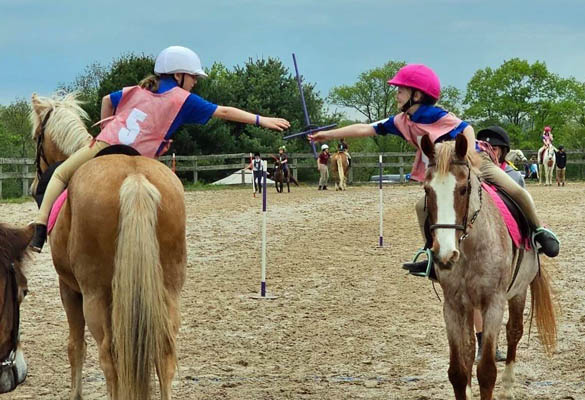So, You Think You Love Horses?
Some Reflections on the Nature of Horses and Man
Glossary of Equestrian Terms
Words Beginning with D
Dales Pony
Dales Pony (Courtesy: Wikipedia and Annapennell)
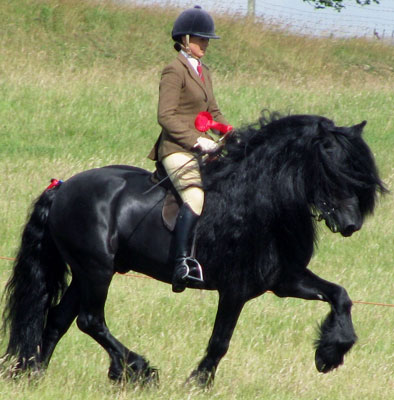
|
[Equine Breed] Dales are a pony breed native to the eastern half of northern England that were originally developed as a pack pony in mines and are now used for riding and driving, It is named for the Yorkshire Dales that are a series of valleys in a region of Yorkshire.
-
Dam
[Pedigree of a Horse] The mother of a individual horse. The grandmother is called a second dam and so on.
-
Dandy Brush
[Grooming Implement] Dandy brushes are one of several types of brushes used for grooming horses. The bristles of a Dandy brush are intermediate between softer body brushes and stiffer bristle brushes. The bristles are made from either natural or synthetic fibers. The handles they are mounted on come in various styles as well. I find under most ordinary circumstances I can get away with using only a Dandy, but it is good to have a variety available when another type is needed.
-
Danubian Horse
[Equine Breed] Danubian horses are a relatively rare breed, native to Bulgaria. They were originally bred as a light draft horse for the Bulgarian Army. They have long heads, a thick, muscular neck and sturdy legs that are clean from feathering.
-
Dapple Gray
19th Century Print of a Dapple Gray
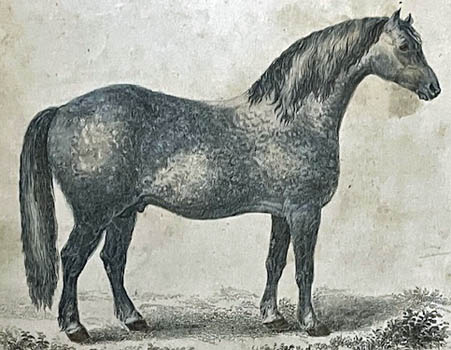
|
[Equine Coloration] A dapple gray horse had a gray coat with a pattern of darker and lighter circles called dapples. The dapples are most noticeable during a horse's prime years and will disappear into a while colored coat as the horse ages.
-
Dark Horse
[Expression as Relates to Horses]
A dark horse is an unknown competitor, who unexpectedly emerges as a winner.
-
Dartmoor Pony
[Equine Breed] Dartmoors are native to the County of Devon, England. Some of them live in a semi-feral state on the open moor itself. They were also ridden by the guards at the infamous Dartmoor Prison in former times.
-
Dead Heat
[Racing] A dead heat is when two race horses finish nose to nose and neither can be said to have beaten the other. They are both recognized as winners and the first and second place prize money is divided between them. This can happen even in our era of photography, but is very rare.
-
Dead Weight
[Racing] Dead weight are lead weights that a jockey must carry in a saddle back in order to match the required carry weight against the assigned weight. This has the effect of evening the playing field.
-
Dee Rings
Dee Ring

|
[Equine Tack] Dee rings are small "D" shaped rings found fixed in various items of tack, including saddles and girths. They are designed to receive straps with snap ends. The "D" shape allows them when not in use to be folded against the contour of the tack.
-
Deep Takeoff Point (Tight Takeoff Point)
[Equestrian Jumping] With a deep takeoff point horse leaves the ground too close to the jump. It makes for an awkward and uncomfortable jump. It results from poor coordination between the horse and rider.
-
Defended Penalty Shot
[Polo] In a defended penalty shot the opposing team may defend the goal. There are multiple types of penalty shots allowed in polo, some defended and others not with various distances set by the particular cause of the penalty.
-
Dental Star
[Equine Dentition] A dental star is yellowish-brown dentin mark on a horse's tooth that helps indicate a horse's age. The dental star appears first on the lower central incisors around age 6, then on the lower intermediates, and finally on the other incisors. Its shape also evolves to become more rounded and its location on the tooth drifts.
-
Dentist (Equine Dentist)
[Equine Practitioner] Equine dentists specialize in the care of horses' teeth. Most licensed veterinarians include these services as well. In many states non-veterinarians are permitted to perform certain equine dental procedures but as yet strict educational standards and licensing are uncommon for those non-veterinarians holding themselves out as equine dentists. Horses' teeth are extremely important to their well-being and regular care required. Over time with grazing irregular sharp edges or hooks form on the occlusal surfaces of teeth. These can interfere with the animals nutrition. A procedure called the floating of teeth removes these irregularities.
-
Depraved Appetite (Pica)
[Equine Behavioral Vice] A horse exhibits a depraved appetite when it eats substances that are not typical food and have no nutritional value. Dirt, wood, bark, hair, and even feces are typical. Coprophagy (eating feces) is felt to be normal in young horses and may be needed to populate the important gut flora need for proper digestion. In adult horses pica may be the result of boredom. Scientific research into the question of pica resulting from nutritional deficiencies have generally failed to establish a correlation. In some horses pica can lead to the formation of bezoars in the gastrointestinal track.
-
Desensitization Clinic
[Equine Training Technique Event] In a desensitization clinic the participates and their horses are introduced to a series of common situations likely to cause a horse to spook (react to fear) and the rider and horse taught how to deal with them. These can be very useful, but it is more important that the rider has mastered basic horsemanship skills and won the confidence of the horse to start with. How well do you reassure your horse when you feel him being fearful? Are you patient and understanding or do you try to bully him past the scarily thing? If you lack a trusting relationship with your horse and you cannot move him in two dimensions with your legs, no one day clinic will solve all your problems.
-
Desensitize
Desensitizing in the 19th Century
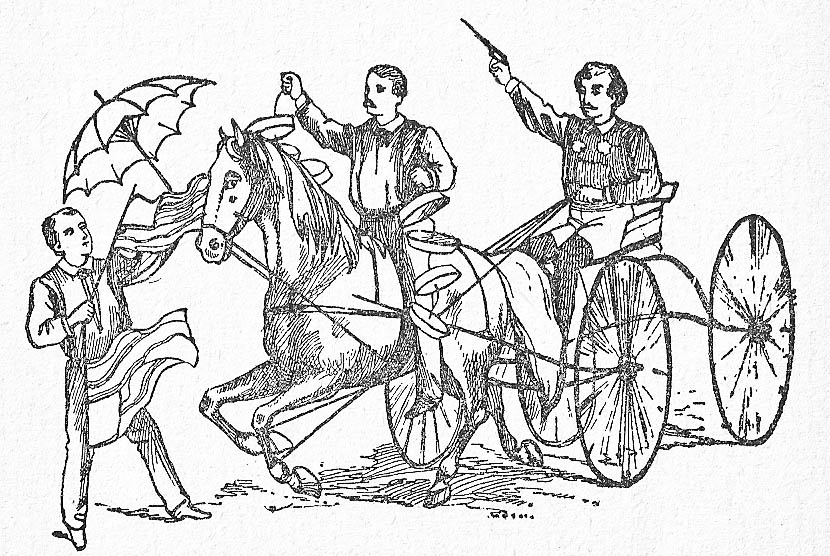
|
[Equine Training Technique] With desensitize a horse is exposed to what causes it to experience a level of fear over and over until it becomes accustomed to it and does not react.
-
Destrier
Joan of Arc on a Destrier
(Public Domain Wikipedia Commons)
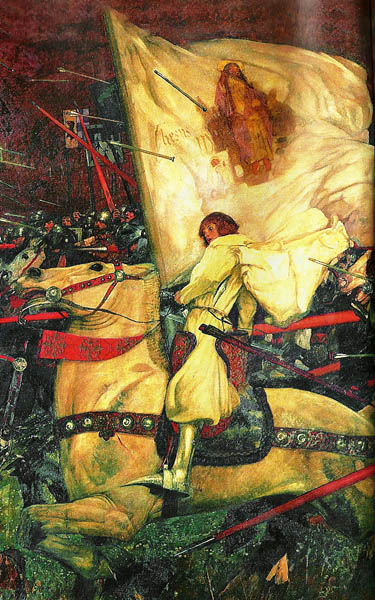
|
[Equine Type] A destrier was a medieval horse type, bred to carry an armored knight into battle or jousts. We often picture them as similar to our modern draft horse breeds but in fact they were likely not quite that large. They were prized and were pampered animals for their time, treated better than most humans. The word is the Latin word for right, the side on which they were led when not in active use.
-
Developmental Orthopedic Diseases
[Veterinary Medicine] Developmental orthopedic diseases are a family of orthopedic conditions that afflict young horses prior to the closure of growth plates.
-
Diagonal
[Equine Gait] Diagonals refer to the horse's movement at a trot. The horse's diagonal pairs of legs move together in a sequence with a moment of suspension in between. The rider's posting should be in rhythm with this. If the horse leads off with the left fore and right hindfeet, it would follow with the right fore and left hind. When riders are trotting in a circle, they should be properly matching their posting to the correct one of two possible pairings in sequence with the horses' diagonals. This is expressed in the rhyme "Rise and fall to the leg by the wall." This is equally true regardless of circling clockwise or counter clockwise. If the horse is moving counterclockwise, the rider should rise in the post when the horse's left foreleg and right hindleg strike the ground and in that situation is said to be on the "left diagonal." When learning this in a ring, I found it hard to see or feel what a horse was doing with its legs under me. Since the horses impulsion in the above scenario is coming mostly from its outside hindleg (side closer to the rail), you should be able to feel when that leg pushes off. If done correctly this is felt to lessen the amount of effort the horse is expending by way of a rational. When working in a ring it is desirable to change direction and work both pairs of diagonals. Since I mostly was a trail rider and not doing ring work, I could forget all about my diagonals.
-
Diastema
Side View of a Horse's Skull showing the Diastema
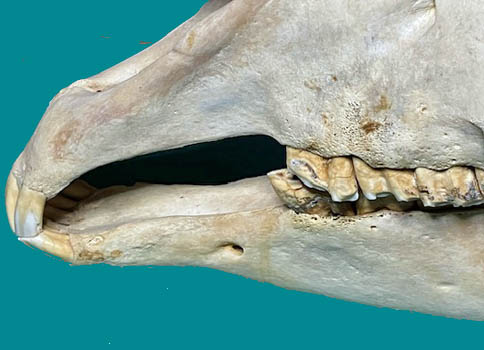
|
[Equine Anatomy] The diastema is a toothless region of the jaw and lower skull between the premolars and the incisors or any wolf teeth that might exist. This open area appears to be the evolutionary response to the lengthening of the horse's face that is believed to have occurred so that the horse has good view of the surrounding land, while it was ground feeding. Other species, for example deer, also have a diastema. Man has taken advantage of this anatomical feature since it is the perfect place to set a bit.
-
Diflubenzuron
[Stable Management] Diflubenzuron is the active ingredient in fly control feed additives that effect fly larva in manure, interrupting its life cycle. It has no effect on adult flies. It is extremely effective in eliminating larva in the manure of treated animals, but there are always flies hatching from untreated neighborhood animals. It disappears from the environment within days and does not seem to effect creatures other than insects.
-
Dimensions of a Horse's Space in Transportation
[Horse Transportation] The U.S. Army determined that the minimal dimension allowed for horses during transportation was 3 1/2 feet wide by10 feet long each. Both men and horses tended to be crowded together in a move to maximize numbers.
-
Dimethyl Sulfoxide (DMSO)
[Veterinary Medicine] Dimethyl sulfoxide is a solvent with little toxicity that has several applications in veterinary medicine. As a solvent it will cause other medications to penetrate the skin better. In its own right it is used as a liniment for horses, and interestingly enough, intravenously for the treatment of increased intracranial pressure and cerebral edema in horses. However, there is a lack of a firm evidence basis for its use at this point. I suspect the feeling is that the condition is serious and DSMO is unlikely to hurt. Also, DMSO is found naturally in the urine of all horses (and many humans) in low amounts and is believed to be of dietary origin. Because of this, in racing there is a threshold value that is permitted.
-
Direct Rein
[Basic Riding] Reins held by the rider such that they are in a straight line from the bit to the rider's elbows. When employed they are drawn directly back toward one of the rider's hips. This is the primary means of controlling a horse's speed and direction. When turning a slight pressure is preferentially exerted on the side to which you wish the horse to turn. This is the first of the five recognized rein aides.
-
Dished Face
[Equine Appearance Attribute] A horse having a dished face shows a concave profile to the nasal dorsum. The opposite profile is called a Roman nose. A dished face is a mark of Arabian blood in a horse's breeding. In certain sub-breeds of Arabians, such as the Royal Egyptian line it has been carried to an extreme.
-
Distaff
[Racing] Distaff indicates a female horse. The term is an old one for of women in general, but has fallen into disuse.
-
Divot
[Result of Horse Activity] A divot is the impression of a horse's hooves in soft ground that often results in a torn up piece of turf. It is possible to restore the ground pushing the turf back and flattening the surrounding ground. Spectator are often invited the fix the divots resulting from a polo match.
-
Dock
[Anatomy of the Horse] The lowest vertebral bone segment of a horse's spine and its covering tissue and skin before ending in the hair of the tail.
-
Docking a Tail
[Obsolete Human Practice with Respect to Horses] The deliberate removal of the lower portions of a horses tail, including most all of the hair. This was done with carriage horses to avoid getting reins caught under the tail and also with some military horses and hunters to avoid brush or foreign objects tangling in a tail.. A docked horse cannot swish flies and the practice is considered outmoded. Temporary braiding or bandaging the tail achieves the same purpose.
-
Doctor Bristol Mouthpiece Snaffle Bit
Doctor Bristol Mouthpiece Snaffle Bit
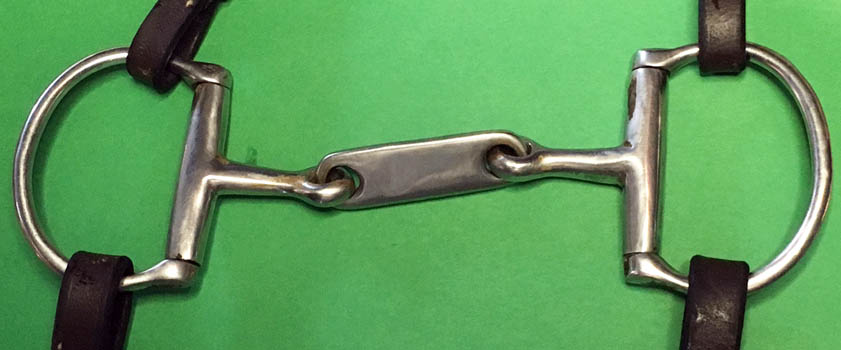
|
[Equine Equipage] Doctor Bristol mouthpiece snaffles are a type of multi-jointed snaffle bits that have a flat link in the center of the mouthpiece which lays at an angle to the plane of the bit. They appear similar to a French link snaffle but the French link is set in the plane of the bit while the Dr. Bristol is at an angle. The French link is considered to be a milder bit than the Dr. Bristol.
-
Doeskin
Doeskin on a Saddle Knee Roll
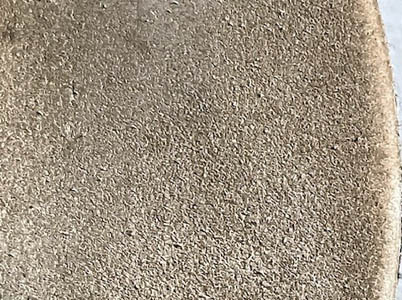
|
[Equestrian Equipage] A fine-haired hide of an adult female deer with a velvet-like texture that is often used in saddles on the seat or knee rolls, where is provides a little more grip. It is challenging to clean but looks attractive.
-
Døle Gudbrandsdal Horse
[Equine Breed] Døle Gudbrandsdal horses are native to Norway. They are a small draft or harness horse that descended in part from the Friesians.
-
Dog Fox
[Fox Chasing] This is a term for a male fox. Vixen is used for the female.
-
Don Horse (Russian Don Horse)
[Equine Breed] The Don horse is native to the Don River Valley in the Russian steppes region. They were bred as war horses for Cossack cavalry. It is a wonder they survived two world wars, famines and the Russian revolution. A small population did and the breed has been rebuilt in modern times.
-
Dorsal Stripe
[Equine Coat Marking] The dorsal stripe is a primitive coat marking commonly found in horses with a dun coat color, as well as other types of equines. It has been selectively bred out of most modern horse breeds with the development of different coat colors centuries ago.
-
Double Clear
[Equestrian Jumping] Double clear is when in a two round jumping competition, the jumper experiences no faults in either round.
-
Drag Hunting
[Scent Chasing] Drag Hunting is similar to fox chasing in that the riders and hounds are following a scent across an outdoor course with jumps and other obstacles. What is different is that the scent has been laid out by a human on foot shorty before the hunt and the scent itself is an odiferous, non-animal based product. This form of hunting should be acceptable to animal rights activists, who are known to make a stink of their own over in Britain. It also gives more control over the course to the hunt. However, some fox chasing purists look down on drag hunting. On the other hand and it seems particularly in Britain, drag hunters seem to attract a lot of fanatical self-appointed monitors, who believe incorrectly that the hunters are actually hunting foxes and try to create a scene during the hunt. It seems like you just cannot please some people.
-
Dragoon
[Military] Dragoons were a type of mounted soldiers that originally used horses for mobility but dismounted to fight on foot. Over time they also fought mounted and other than the name, there was little distinction between dragoons and cavalry.
-
Draw Reins
[Schooling] Draw reins are a set of additional reins that go through bit rings and attach to the saddle's girth. They are used in schooling a horse to lower their head and flex their neck at the poll, but not used in ordinary riding. You can get perfectly good head carriage in a horse without them and I suspect they are simply a short cut.
-
Dressage
[Equestrian Discipline] In dressage the riders demonstrate their ability to have schooled the horse to an idea level of performance. Dressage is undertaken in a prescribed ring using a stipulated sequence of actions as called for in what is referred to as a dressage test. These tests are carried out at progressive levels of training (training scale). They begin with fairly easy demonstrations of simple movements and transitions and advance all the way to international competitions, including the Olympics. Dressage may lack the excitement of some other riding disciplines for spectators, but to the connoisseur there is no more pure example of ideal equestrianism, horse and rider moving flawlessly as one.
-
Dressage Test
[Equestrian Competition] Dressage riders compete with each other by performing in judged events that are called tests. These would be the equivalence of classes in other types of horse shows. Riders at the same level preform a stipulated sequence of actions in a ring marked of with letters that establish points where transitions are to take place. They are awarded points by the judge or judges based on how well they performed the action. I suspect no other riding discipline is so demanding as dressage.
-
Dressage Whip
Dressage Whip

|
[Equestrian Equipage] A dressage whip is a short whip designed to be used while both hands are on the reins. It just reaches the horse's flanks and is valuable as an additional aid to reinforce the rider's legs. Sidesaddle riders may carry a whip in the dressage tests at all competitions, but they are not permitted for those riding astride in the more advanced championship divisions. A horse is not really whipped but just tapped with a dressage whip. It is also often used if needed while loading a horse on a trailer.
-
Driving
[Form of Employing a Horse and Vehicle] Driving is the term describing the hitching of one of more equines to a wagon, carriage, cart, sleigh, or other horse-drawn vehicle, using a harness. Some would say it is a lost art but that is not entirely fair. There are still people who drive horses for pleasure, in competitions, as a conveyance for tourists, in harness racing or even among the Amish for everyday transportation or work, etc. Interestingly enough, the driver of a carriage in both the U.S. and U.K. are generally seated on the right side of the seat, even though the vehicles are driven on different sides of the road.
-
Driving Hand
[Driving] In driving the term driving hand generally indicates the left hand, while the term whip hand is the hand reserved for the whip or the right hand.
-
Drop Fence
[Show Jumping] A jump construction in which the landing side is lower than the take-off.
-
Dutch Warm Blood Horse
The Dutch dressage rider Marlies van Baalen on Dutch Warm Blood Kigali
(Public Domain Wikipedia Commons)
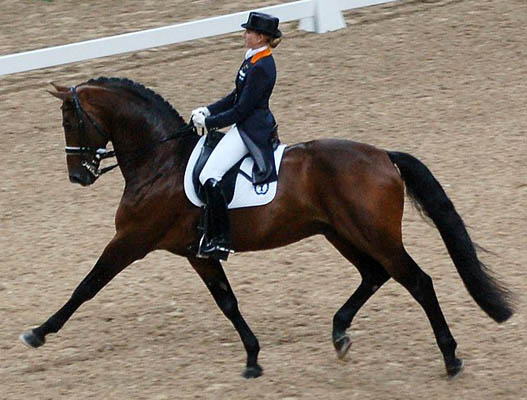
|
[Horse Breed] Dutch Warm-bloods are a warm-blood breed that originated in the Nederlands. There were carriage and draft animals in their ancestry but the breeders wished to produce a light horse, while retaining many of the favorable characters, such as strength seem in their forebears. Strict selection procedures applied to breeding stock produces reliable animals seen frequently seen today in dressage or jumping competitions.
-
Dun
[Equine Coat Color] Dun horses have a light yellow or golden body with black or brown legs and tail and are often accented with various other primitive markings. This approximates the nature coloration of the original wild horses.
Glossary of Equestrian Terms: Main Alphabetical Listing
Links to Other Sites with Equestrian Interests
Back to Introduction
